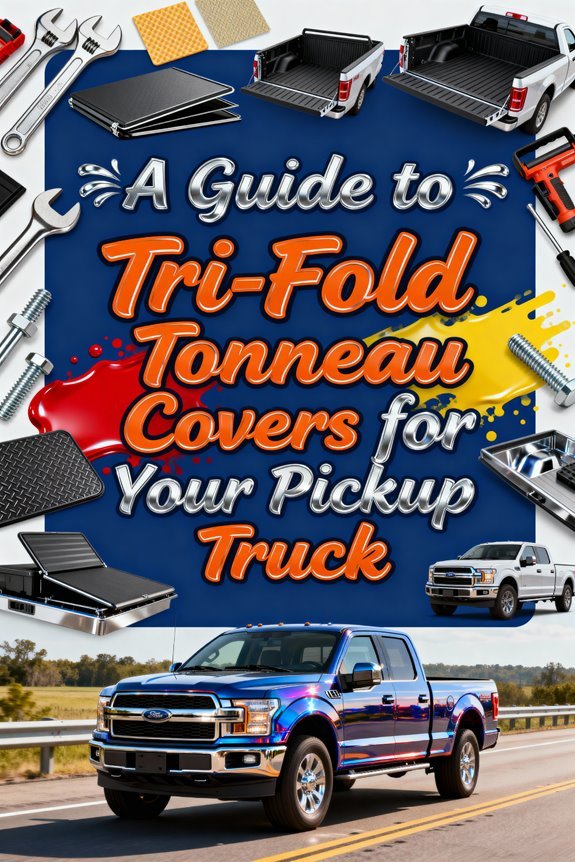Tonneau covers do improve fuel economy, though the gains are modest. You’ll see drag reductions averaging 5-7%, which translates to real-world fuel savings of 1-2% in mixed driving conditions. The benefits increase considerably during highway travel above 55 mph, where some trucks achieve 5-10% improvements due to reduced wind resistance. Hard covers typically outperform soft versions aerodynamically. While the fuel savings alone may take years to offset the $200-$1,000+ purchase price, understanding the complete aerodynamic science and additional benefits reveals their true value proposition.
The Science Behind Aerodynamics and Truck Bed Design
When air strikes your truck’s cab at highway speeds, it doesn’t simply flow over and around the vehicle—it separates, tumbles into the open bed, and creates a churning vortex of high-pressure turbulence that acts like an invisible parachute dragging behind you. This phenomenon violates fundamental aerodynamic principles by maximizing your truck’s drag coefficient. The open cavity between cab and tailgate traps swirling air masses that greatly increase resistance. Modern truck bed design inherently creates this aerodynamic penalty. Tonneau covers eliminate the vortex by smoothing airflow across the bed’s surface, reducing your drag coefficient by an average of 5.73% in wind tunnel testing. Hard covers deliver superior results—some achieving 6.5% reductions—because their rigid, continuous surfaces maintain ideal airflow attachment and minimize turbulent separation. These covers are typically constructed from sturdy plastics or metals, making them more resistant to environmental stress than their fabric counterparts. Beyond aerodynamics, tonneau covers also keep cargo out of sight and employ locking mechanisms that deter theft from your truck bed. This drag reduction forces the engine to work less hard, directly translating to measurable improvements in fuel consumption during highway driving.
What Research and Testing Reveal About Fuel Savings
Although laboratory tests consistently demonstrate drag reduction with tonneau covers, the translation to measurable fuel savings remains contentious in scientific literature. SEMA’s late-1990s studies showed up to 12% drag reduction in controlled environments, yet their testing methodologies focused on aerodynamic coefficients rather than actual consumption. MythBusters’ 2006 empirical tests found no significant MPG difference at 25 or 55 mph, while Consumer Reports’ real-world evaluations confirmed negligible improvements. Industry sources claim 5-10% fuel savings, but data-driven analysis reveals most legitimate estimates hover around 1-2% under ideal conditions. The disconnect between wind tunnel results and on-road performance stems from variable driving patterns, speeds, and cargo loads that laboratory testing methodologies fail to replicate, making quantifiable fuel savings difficult to validate consistently. Tonneau covers work by reducing wind drag over the bed, which theoretically decreases the resistance that forces your engine to work harder at highway speeds. Beyond fuel economy considerations, tonneau covers provide protection against weather elements that can prevent cargo damage and extend the functional lifespan of truck bed contents. The versatility of tonneau cover styles allows customization for different hauling needs, while they can also enhance the truck’s resale value by adding a desirable feature.
How Different Tonneau Cover Styles Impact Performance
Each tonneau cover style produces distinct aerodynamic profiles that directly affect drag coefficients and fuel efficiency outcomes. Retractable and hard rolling covers create smoother airflow across your truck bed, reducing turbulence by as much as 10% compared to open configurations. Tonneau cover materials considerably influence performance—aluminum hard covers maintain aerodynamic integrity at highway speeds, while soft vinyl covers may flutter, disrupting airflow patterns. Hard folding covers offer peak drag reduction when fully closed, though panel joints can create minor air resistance. Cover installation challenges affect performance consistency; improperly sealed edges allow air infiltration, negating fuel economy benefits. Soft roll-up covers provide moderate aerodynamic improvement but compromise efficiency when partially retracted. Your fuel savings correlate directly with cover rigidity and seamless integration with your truck’s cab profile. Hinged one-piece covers deliver exceptional weatherproofing and eliminate panel gaps that can disrupt airflow, though their single-panel design makes them cumbersome to operate for frequent bed access. The clamp system used in many tonneau covers allows for secure attachment to truck bed rails without drilling, maintaining both aerodynamic performance and vehicle integrity. Regular maintenance includes inspecting and lubricating mechanical parts such as hinges, tracks, and locks to ensure smooth operation and preserve aerodynamic performance.
Understanding Drag Reduction and Its Real Effects
The aerodynamic advantages you’ve examined translate into measurable drag coefficients, but the actual fuel economy benefits don’t always match theoretical predictions. Western New England College documented a 12% drag coefficient reduction, while Department of Energy highway tests showed 10% fuel economy gains. However, MythBusters found negligible improvements at 25 and 55 mph. This discrepancy stems from how airflow patterns interact with your truck’s specific geometry and driving conditions. Highway speeds maximize drag reduction benefits since aerodynamic resistance increases exponentially with velocity. City driving negates these advantages through frequent stops and lower speeds. Your tonneau cover’s weight adds mass that counteracts drag reduction gains. The net efficiency improvement depends on whether streamlined airflow patterns offset the added weight penalty under your typical driving conditions. SEMA wind tunnel tests demonstrated a 5.73% drag reduction on average across different tonneau cover types and truck models. Electric trucks like the Tesla Cybertruck have shown a 10-15% improvement in energy consumption with a closed bed cover at highway speeds. Premium covers with robust aluminum frames are engineered to maintain their aerodynamic profile even at sustained highway speeds, ensuring consistent drag reduction performance.
Highway Versus City Driving: When Does It Matter Most?
Where does your truck spend most of its time—cruising at 65 mph on interstates or crawling through 25 mph urban streets? This distinction determines whether you’ll see actual fuel savings from a tonneau cover. Highway efficiency gains are measurable—real-world tests document 7.7% MPG improvements on Ram 1500s at sustained speeds where aerodynamic drag dominates fuel consumption. Wind resistance grows exponentially above 50 mph, making drag reduction meaningful at interstate velocities.
City limitations are stark by comparison. Stop-and-go traffic negates aerodynamic benefits entirely. Frequent acceleration and braking overpower any drag coefficient improvements, with studies showing zero significant MPG difference in urban environments. Your engine load and constant speed variations matter far more than airflow optimization when you’re idling at red lights and accelerating to 35 mph. Hard top covers deliver superior streamlining compared to soft-shell alternatives, maximizing whatever aerodynamic advantage exists at highway speeds. While hard covers range from $500 to over $2,000, their aerodynamic performance justifies the premium for highway-heavy drivers seeking maximum efficiency gains. Tri-fold hard covers also offer the added benefit of easy installation and compatibility with truck toolboxes, making them a practical choice for drivers who need both aerodynamic efficiency and versatile bed access.
Weighing the Costs Against Potential Fuel Savings
Understanding where tonneau covers deliver measurable gains leads directly to the financial calculation: does aerodynamic improvement justify the purchase price? You’ll find initial investments ranging from $200 for lightweight soft covers to $1,000+ for premium hard models. With fuel savings between 2-10% depending on driving conditions, your payback period hinges on annual mileage and fuel costs. Highway-dominant drivers logging 15,000+ miles yearly may recoup costs within two years, while urban commuters face extended timelines. Cost effectiveness improves when selecting lightweight covers that maximize drag reduction without weight penalties. These soft roll-up and soft folding designs represent the best tonneau cover options for fuel efficiency since they reduce drag without adding substantial weight. Hard covers constructed from aluminum or fiberglass provide enhanced security and durability but may add weight that offsets aerodynamic gains. Purchase considerations must include installation complexity, durability, maintenance requirements, and replacement frequency. Models like the TruXedo TruXport balance affordability with aerodynamic performance, making them practical choices for fuel-conscious buyers. Heavier covers offering minimal aerodynamic advantage over their weight penalty deliver poor cost-benefit ratios, undermining fuel economy objectives.
Primary Benefits Beyond the Gas Pump
While fuel savings command initial attention, tonneau covers deliver quantifiable advantages across cargo management, vehicle longevity, and operational efficiency. You’ll gain superior cargo security through hard covers constructed from cut-resistant materials with integrated locking mechanisms, while soft variants keep contents concealed from potential theft. Weatherproof seals prevent water ingress and debris accumulation, protecting sensitive equipment during transport.
Truck bed organization improves dramatically as covers work with aftermarket dividers and storage systems to maximize usable space. You’ll secure smaller items that would otherwise blow out at highway speeds, reducing loading time and simplifying gear access. The cover prevents cargo shifting during transport, keeping items neatly placed and eliminating the need to rearrange loads after driving. Soft roll-up covers made of vinyl or canvas easily roll toward the cab for full bed access when you need to load larger cargo.
The protective barrier also shields bed finishes from UV degradation and scratches, preserving paint integrity and potentially increasing resale value. Tonneau covers contribute to a cleaner, more finished appearance that enhances your truck’s overall aesthetic appeal. These functional benefits often outweigh aerodynamic gains in total ownership value.
What Truck Owners Report From Real-World Experience
Highway driving reveals the most significant fuel economy improvements from tonneau covers, with truck owners reporting gains between 4-5% when maintaining speeds above 55 mph. These real world experiences consistently link improvements to reduced aerodynamic drag at steady highway speeds, though results vary by truck model, cover type, and installation quality. User testimonials emphasize that hard covers deliver superior aerodynamic benefits compared to soft variants, while proper fitment without gaps proves critical for maximizing efficiency gains. Stop-and-go urban driving shows negligible improvements where aerodynamics play minimal roles. Some owners remain skeptical, noting that personal mileage tests often fall within measurement error margins. The engine works harder without a tonneau cover, as increased drag forces require additional fuel consumption to maintain highway speeds. Independent testing confirms modest real-world gains compared to wind tunnel predictions, validating owner observations that fuel savings remain subtle rather than transformative. Truck owners seeking maximum durability and weather protection often choose fiberglass tonneau covers, which combine superior aerodynamics with long-lasting construction that resists sun and water damage better than fabric alternatives. While no cover provides absolute protection, EPDM rubber seals help minimize water intrusion at edges where the cover meets the truck bed.
Making an Informed Decision for Your Pickup
Should you invest in a tonneau cover purely for fuel savings? The data suggests you’ll need to calculate your specific return on investment. If you’re driving primarily highway miles at speeds where drag reduction matters most, lightweight tonneau types like soft roll-up or soft folding covers offer the best aerodynamic benefit without weight penalties. Studies show up to 12% drag reduction and potential 10% fuel economy improvements, but results vary considerably based on driving conditions.
Consider the complete value proposition: cargo protection, improved vehicle appearance, and security alongside potential fuel savings. However, Consumer Reports testing revealed that covered bed configurations actually decreased fuel mileage compared to open bed setups, with the tailgate-down configuration performing best. Match your cover selection to your driving patterns. Highway-dominant drivers see measurable returns; city drivers won’t. Retractable tonneau covers can deliver 5-10% fuel efficiency gains through reduced wind drag while offering flexibility and enhanced security features. Hard folding covers with rigid aluminum panels provide excellent durability and weather resistance while maintaining aerodynamic benefits. Calculate payback period against cover costs, factoring in additional benefits beyond fuel economy alone.

